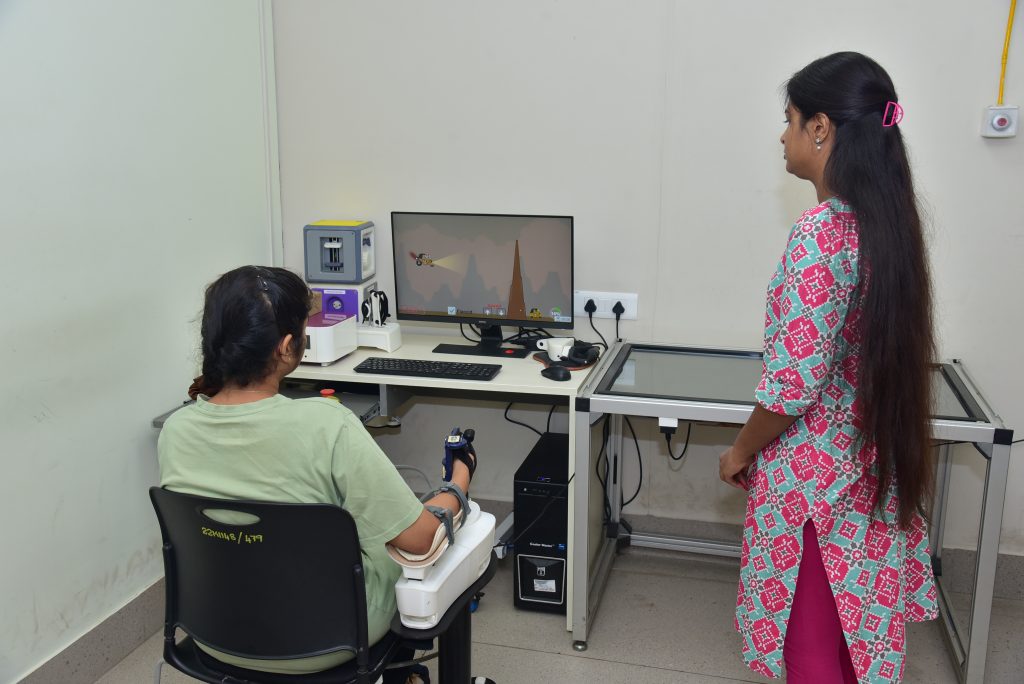Stroke
Stroke and Cerebrovascular Services
The Department of Neurology at CMC Vellore has been offering cutting-edge treatment for stroke and other cerebrovascular diseases. This is made possible by a dedicated multidisciplinary team of doctors, nurses, and paramedical staff equipped with updated technology and engaging in clinical research relevant to our patients. We have been awarded the World Stroke Organization’s (WSO) Angels Award for the ‘Best Management of Stroke Patients,
For giving quality care to our patients, we have a stroke team consisting of stroke neurologists, neurointensivists, stroke nurses, occupational therapists, physiotherapists, speech and language therapists, clinical psychologists, and social workers. This team works closely with emergency room physicians, neurosurgery, neuroradiology, interventional neuroradiology, the physical medicine and rehabilitation department, cardiology, and vascular surgery.
Acute stroke treatment
We have an acute stroke code, and routinely, IV thrombolysis and mechanical thrombectomy are done. Even challenging cases of stroke, like in pregnancy, etc., are being treated with thrombolytic and endovascular therapies. Also, we have pioneered the use of sonothrombolysis in India. We had explored the role of Ayurvedic Treatment of Acute Ischemic Stroke and also studied the best ways to differentiate stroke mimics in an emergency room setting.
Another major type of stroke seen in our country is venous strokes or Cerebral venous thrombosis (CVT) ; a condition mainly affecting the young . Our department has been pioneering many aspects of both the diagnosis and treatment of CVT. We had shown the benefit of surgery in malignant CVT and also pioneered the use of mechanical thrombectomy in the treatment of CVT cases refractory to medical therapies. There are many ongoing research projects conducted by the department on this rare condition.
Stroke Rehabilitation
Both outpatient and inpatient rehabilitation for stroke is being done by a team of physiotherapists, occupational therapists, and speech therapists overseen by our physical medicine and rehabilitation department. Routine physiotherapy as well as advanced robotic rehabilitation are done as per the patients’ deficits. Chemo-denervation therapies with botulinum toxin injections are routinely given for post-stroke spasticity. Therapies, including transcranial magnetic stimulation and transcranial direct current stimulation, are also used in selected cases. Our bioengineering department works closely with us to develop novel devices for stroke rehabilitation.

Secondary preventative strategies
A team of stroke nurses is involved in educating the patient and the caregivers regarding stroke mechanisms and secondary preventive measures.
We do extensive workups, especially to find the etiology in young stroke patients. We regularly manage rare acquired and genetic causes of stroke, including vasculitis, thrombophilia, mitochondrial disorders, etc. We have developed a genetic panel and identified polymorphisms contributing to strokes in young Indians. We do antiplatelet drug resistance tests for selected patients with a high chance of stroke recurrence, especially with intracranial atherosclerosis (ICAD). Transcranial Doppler studies (TCD) are being conducted as part of the diagnostic workup in young cryptogenic stroke patients suspected to have a patent foramen ovale (PFO), and if indicated, closure is done by our cardiology team. Critically stenosed carotid arteries are evaluated by perfusion studies and vasomotor reactivity tests, and if needed, carotid stenting or endarctomy is done by our neuroradiology intervention team and our vascular surgery team. Direct and indirect revascularization surgeries are done by our neurosurgery colleagues for diseases like Moya Moya syndrome.
Stroke Clinic
After discharge, the patients are followed up in the stroke clinic. This is a multidisciplinary clinic where neurologists, stroke nurses, doctors from the physical medicine and rehabilitation department, occupational therapy, physiotherapy, speech and language therapists, clinical psychologists, and social workers assess and address both stroke patients and their caregivers needs. We have separate programs for assessing and addressing the stroke caregiver burden.
Training
Apart from training the DM Neurology residents in stroke management, we also run a one-year Post-Doctoral Stroke Fellowship program. The candidates will also be imbibing hands-on skills during their rotations in: (1) interventional radiology for acute stroke interventions; (2) neuro-critical care for acute stroke care; and (3) the Department of Physical Medicine and Rehabilitation for post-stroke rehabilitation.
Outreach
We have established networking with hospitals around our institution for the quick implementation of therapies for acute stroke through a drip and ship strategy. We also conduct workshops and seminars to spread awareness regarding acute stroke therapies among general practitioners, who are often the first contact for stroke victims, as well as among the general public.
Research
The department is currently involved in many international clinical trials and research projects in stroke and cerebral venous thrombosis, ranging from acute therapies to secondary prevention and rehabilitation.